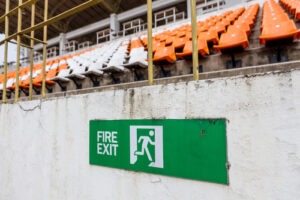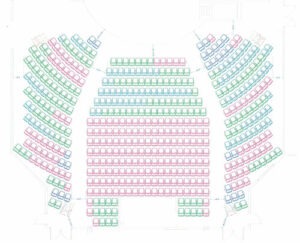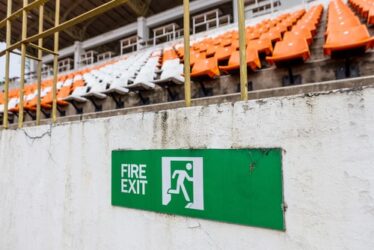Compliance with IBC Codes for Auditorium and Theater Design: Exits, Handrails, Aisle Widths, Floor Slopes, and Riser Heights
 Auditorium and theater design must adhere to various safety codes and regulations to ensure the well-being and comfort of occupants. The International Building Code (IBC) provides specific guidelines regarding the location and number of exits, handrail placement, aisle widths, floor slopes, and riser heights. In this article, we will explore these key codes for auditorium design, emphasizing their significance in creating safe and accessible spaces for all.
Auditorium and theater design must adhere to various safety codes and regulations to ensure the well-being and comfort of occupants. The International Building Code (IBC) provides specific guidelines regarding the location and number of exits, handrail placement, aisle widths, floor slopes, and riser heights. In this article, we will explore these key codes for auditorium design, emphasizing their significance in creating safe and accessible spaces for all.
Location and Number of Exits
The IBC outlines requirements for the location and number of exits in auditoriums and theaters to facilitate safe evacuation. Key considerations include:
Occupant Load and Exit Calculation:
- Determines the required number and size of exits based on the occupant load and occupancy type of the auditorium.
- Proper calculations ensure that there are sufficient exits to accommodate the maximum number of occupants in a timely manner.
Exit Placement:
- Exits should be strategically located to provide even distribution throughout the auditorium.
- They should be easily identifiable and easily accessible from all seating areas, allowing for efficient evacuation during emergencies.
 Location of Handrails
Location of Handrails
Handrails are essential safety features that provide support and stability. The IBC provides guidelines for their placement in auditoriums, considering accessibility and usability. Key considerations include:
Stairways and Ramps:
- Handrails are required on both sides of stairways and ramps within the auditorium or theater.
- They should be continuous and extend the full length of the stairway or ramp, offering a consistent gripping surface.
Seating and Aisle Areas:
- Handrails should be provided along steps and aisles, particularly in areas with a change in elevation or where there may be an increased risk of falls.
Aisle Widths
 Adequate aisle widths are crucial for safe and efficient movement within the auditorium. The IBC provides guidelines to ensure unobstructed passages and easy evacuation. Key considerations include:
Adequate aisle widths are crucial for safe and efficient movement within the auditorium. The IBC provides guidelines to ensure unobstructed passages and easy evacuation. Key considerations include:
Minimum Aisle Width:
- This defines the minimum required aisle width based on the occupant load and the arrangement of seating within the auditorium.
- These guidelines help prevent congestion and allow for safe and unimpeded movement during normal operations and emergency situations.
Accessible Aisles:
- Accessible seating areas and paths of travel should have wider aisles to accommodate individuals using wheelchairs or mobility devices.
- The coding specifies the minimum width required for accessible aisles to ensure compliance with accessibility standards.
Floor Slope and Riser Heights
 The IBC provides regulations regarding floor slopes and riser heights to enhance safety and accessibility within the auditorium or theater. Key considerations include:
The IBC provides regulations regarding floor slopes and riser heights to enhance safety and accessibility within the auditorium or theater. Key considerations include:
Floor Slope:
- Setting limits on floor slopes to prevent excessive inclines that may pose a risk of tripping or falling.
- Slopes within the auditorium should be within the specified limits to ensure safe and comfortable movement for all occupants.
Riser Heights:
- Riser heights for steps and tiers within the auditorium should be consistent to promote safe and predictable movement.
- The coding provides guidelines to maintain uniform riser heights and prevent potential tripping hazards.
Compliance with IBC codes for auditorium design regarding the location and number of exits, handrail placement, aisle widths, floor slopes, and riser heights is crucial to ensure the safety, accessibility, and comfort of occupants. By adhering to these codes, designers and building owners can create auditoriums that prioritize occupant safety, facilitate efficient evacuation, and provide a positive experience for all attendees.






